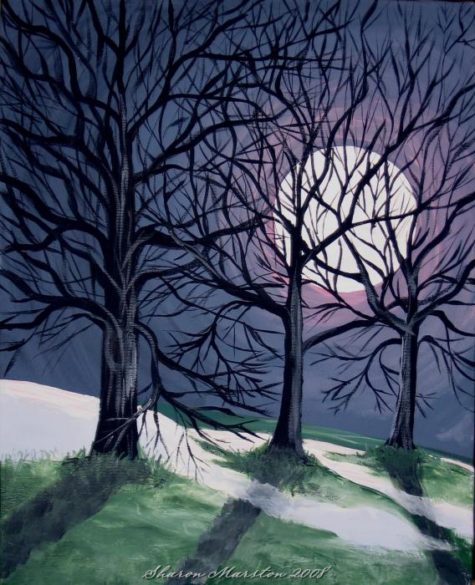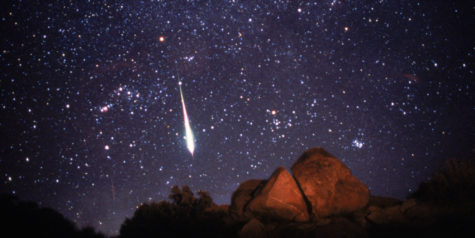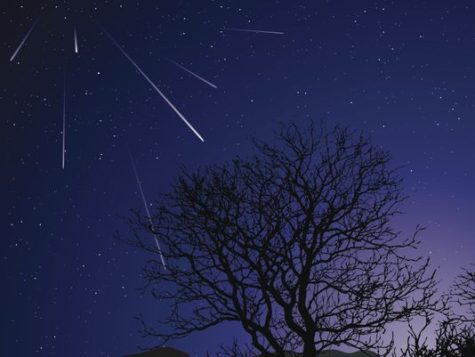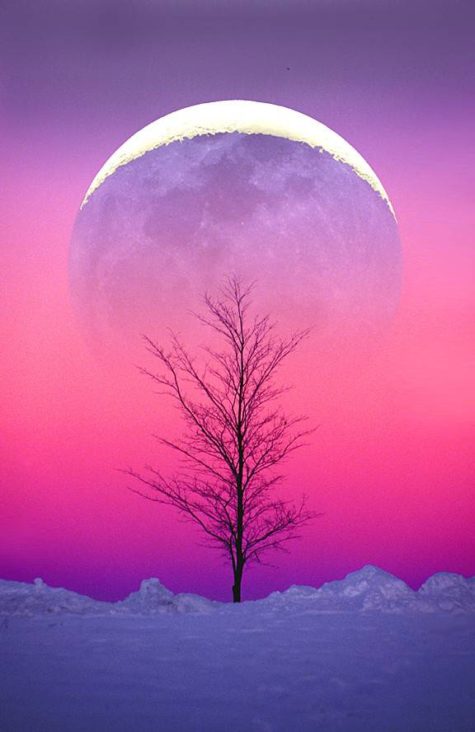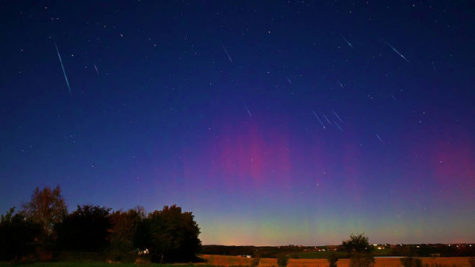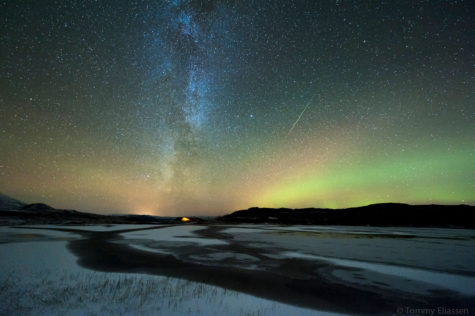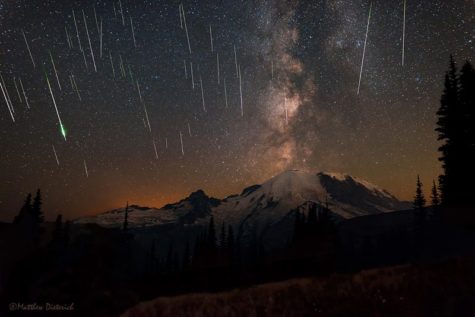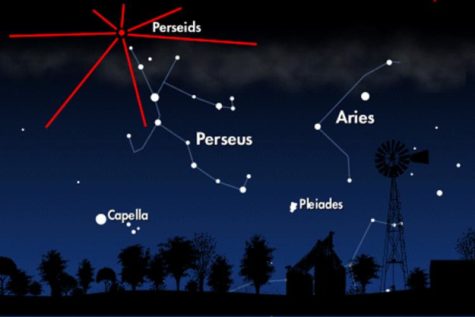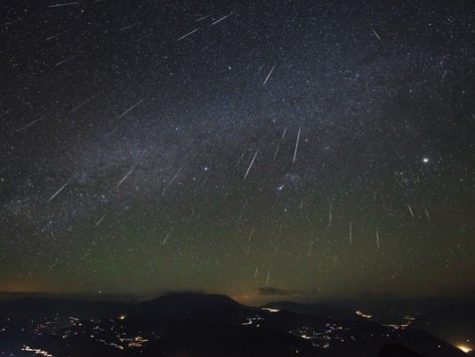Almanac Events
The Geminids is the king of the meteor showers. It is considered by many to be the best shower in the heavens, producing up to 120 multicolored meteors per hour at its peak. It is produced by debris left behind by an asteroid known as 3200 Phaethon, which was discovered in 1982.
The shower runs annually from December 7-17. It peaks this year on the night of the 13th and morning of the 14th. Best viewing will be from a dark location after midnight. Meteors will radiate from the constellation Gemini, but can appear anywhere in the sky.
The last moon phase of the year is the Big Winter Moon in December, also called Long Nights Moon, or the Cold Moon.
Correspondences:
- Colors: White, red, and black
- Gemstones: Obsidian, ruby, serpentine
- Trees: Pine, holly
- Gods: Minerva, Osiris, Athena, Persephone and Hades
- Herbs: Ivy, mistletoe, holly and berries, cinnamon
- Element: Fire
As the days get shorter and Yule approaches with the longest night of the year, we force ourselves to get through the darkness because eventually we will see the sunlight and warmth again. Think about the things in your life that you’ve had to endure. Sometimes, a part of us must die in order to be reborn. Now is the perfect time for spiritual alchemy — time to evaluate your life, and know that you’ll survive the dark times.
If you’ve already put the darkness behind you, take your good fortune and share it with others. When it’s cold outside, open your heart and home to friends and family. Reach out to people who might be suffering from the chill of winter, either spiritually or physically.
source: about.com
The Leonids is an average shower, producing up to 15 meteors per hour at its peak. This shower is unique in that it has a cyclonic peak about every 33 years where hundreds of meteors per hour can be seen. That last of these occurred in 2001. The Leonids is produced by dust grains left behind by comet Tempel-Tuttle, which was discovered in 1865. The shower runs annually from November 6-30. Best viewing will be from a dark location after midnight. Meteors will radiate from the constellation Leo, but can appear anywhere in the sky.
Source: SeaSky
The Taurids is a long-running minor meteor shower producing only about 5-10 meteors per hour. It is unusual in that it consists of two separate streams. The first is produced by dust grains left behind by Asteroid 2004 TG10. The second stream is produced by debris left behind by Comet 2P Encke. The shower runs annually from September 7 to December 10. Best viewing will be just after midnight from a dark location far away from city lights. Meteors will radiate from the constellation Taurus, but can appear anywhere in the sky.
Source: SeaSky
November’s Full Moon beckons us to look deep within. With the Sun in Scorpio, the Snow Moon is a potent time to look beyond the obvious. This is an excellent time for dreamwork and lends its energies easily to meditation and divinatory efforts as well as projects that require endings. Use the Snow Moon’s energy for setting magickal goals into motion, as well as planning for the reinvention of your life.Take advantage of this transitional period to set your goals for the future in motion.
~From: 2008 Witches’ Spell-A-Day Almanac
What is a supermoon? The word supermoon didn’t come from astronomy. Instead, it came from astrology. Astrologer Richard Nolle of the website astropro.com takes credit for coining the term supermoon. In 1979, he defined it as:
…a new or full moon which occurs with the moon at or near (within 90% of) its closest approach to Earth in a given orbit (perigee). In short, Earth, moon and sun are all in a line, with moon in its nearest approach to Earth.
By this definition, according to Nolle, there are 4-6 supermoons a year on average.
The full moon of November 14, 2016 is not only the biggest, closest and brightest supermoon of this year. It’s the closest supermoon since January 26, 1948. Should you watch for this full moon on the night of November 14? Sure, and, if you do, it’ll be beautiful. But, for us in the Americas the moon is closer to full on the night of November 13.
The moon turns precisely full on November 14, 2016 at 13:52 UTC. This full moon instant will happen in the morning hours before sunrise November 14 in western North America and on many Pacific islands, east of the International Date Line. (See worldwide map below.)
In Asia and Australia, the moon turns precisely full during the evening hours of November 14. In New Zealand, it actually happens after midnight November 15. Around the longitudes of Europe or Africa, look both nights.
Better yet … everyone, look both nights!
The moon will look plenty full and bright all night long on both nights – November 13 and 14 – as it rises in the east around sunset, climbs highest up around midnight, and then sets in the west at or near sunrise.
The moon won’t come this close to Earth again until November 25, 2034.
Astronomers call this sort of close full moon a perigee full moon. The word perigee describes the moon’s closest point to Earth for any given month. Five years ago – when the closest and largest full moon fell on March 19, 2011 – many began using the term supermoon. In the following years, we heard this term again to describe the year’s closest full moon on May 6, 2012, and again on June 23, 2013, and again on August 10, 2014, and yet again on September 28, 2015.
Now the term supermoon is being used a lot, and, personally, we approve! It’s a good descriptive term for the closest full moons, much easier to remember than perigee full moon.
Last month’s full moon – on October 16, 2016 – was also a supermoon. But the November full moon is even more super! In other words, the time of full moon falls even closer to the time of the moon’s closest point to Earth.
The next supermoon falls on December 3, 2017.
Source: EarthSky
The Draconids is a minor meteor shower producing only about 10 meteors per hour. It is produced by dust grains left behind by comet 21P Giacobini-Zinner, which was first discovered in 1900. The Draconids is an unusual shower in that the best viewing is in the early evening instead of early morning like most other showers. The shower runs annually from October 6-10. Best viewing will be in the early evening from a dark location far away from city lights. Meteors will radiate from the constellation Draco, but can appear anywhere in the sky.
Source: SeaSky
The Orionids is an average meteor shower producing up to 20 meteors per hour at its peak. It is produced by dust grains left behind by comet Halley, which has been known and observed since ancient times. The shower runs annually from October 2 to November 7. Best viewing will be from a dark location after midnight. Meteors will radiate from the constellation Orion, but can appear anywhere in the sky.
Source: SeaSky
Get set for the meteoritic grand finale of summer. The middle week of August is the peak of the Perseid meteor shower.
The Perseids is one of the best meteor showers to observe, producing up to 60 meteors per hour at its peak. It is produced by comet Swift-Tuttle, which was discovered in 1862. The Perseids are famous for producing a large number of bright meteors. The shower runs annually from July 17 to August 24. Best viewing will be from a dark location after midnight. Meteors will radiate from the constellation Perseus, but can appear anywhere in the sky.
It peaks this year (2017) on the night of August 12 and the morning of August 13. The waning gibbous moon will block out many of the fainter meteors this year, but the Perseids are so bright and numerous that it should still be a good show.
Of course, like with any meteor shower, it’s worth starting to watch a few days prior to the peak date. Although meteor streams like the Perseids have been modeled and mapped over the years, there are still lots of surprises out there. Plus, starting an early vigil is insurance that you at least catch some action in the event that you’re clouded out on game day! The Perseids are already active, spanning a season from July 17th to August 24th.
Here’s a sky map:
Source: SeaSky and other sources
The Delta Aquarids is an average meteor shower that can produce up to 20 meteors per hour at its peak. It is produced by debris left behind by comets Marsden and Kracht. The shower runs annually from July 12 to August 23. Best viewing will be from a dark location after midnight. Meteors will radiate from the constellation Aquarius, but can appear anywhere in the sky.
Source: SeaSky

